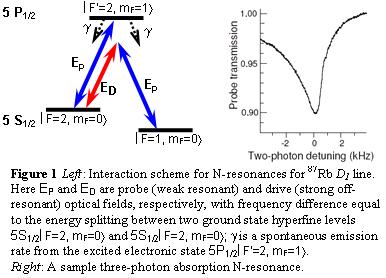|
Three-photon absorption N-resonance
A promising alternative to a CPT resonance is a three-photon absorption resonance (an "N-resonance")[1]. As in the case of the CPT resonance, there are two optical fields involved. A weak probe field, EP, is resonant with the transition between the higher-energy hyperfine level of the ground electronic state |F=2, mF=0> and an excited state, and optically pumps the atoms into the lower hyperfine level |F=1, mF=0>. The strong drive field, ED, is far-detuned from either optical transitions; if the frequency difference between EP and ED is equal to the hyperfine frequency, a two-photon resonance is created, driving the atoms coherently from state |F=1, mF=> to |F=2, mF=0>, followed by a one-photon absorption from field EP. Such three-photon nonlinear process creates the narrow resonance in probe transmission, shown in Fig.1. Roughly speaking, the three-photon N-resonance is an all-optical realization of the double-resonance technique, where the direct coupling of two ground hyperfine states by a microwave fields produces a dip in a resonant optical field. Attractive features of N-resonances for atomic frequency standards include high resonance contrast, leading-order light-shift cancellation, more freedom in the choice of optical transitions, and less sensitivity than coherent population trapping (CPT) resonances to high buffer gas pressures [2,3], which may provide improved short and medium term frequency stability compared to miniature CPT clocks.
References |
